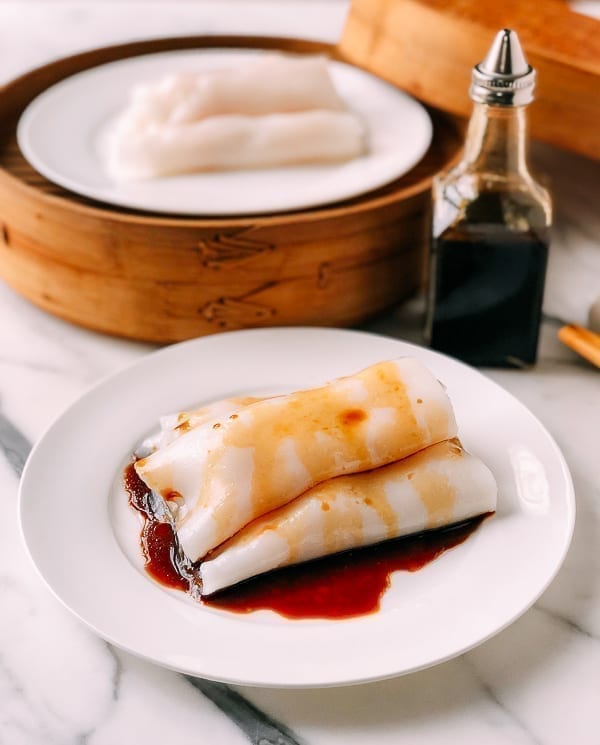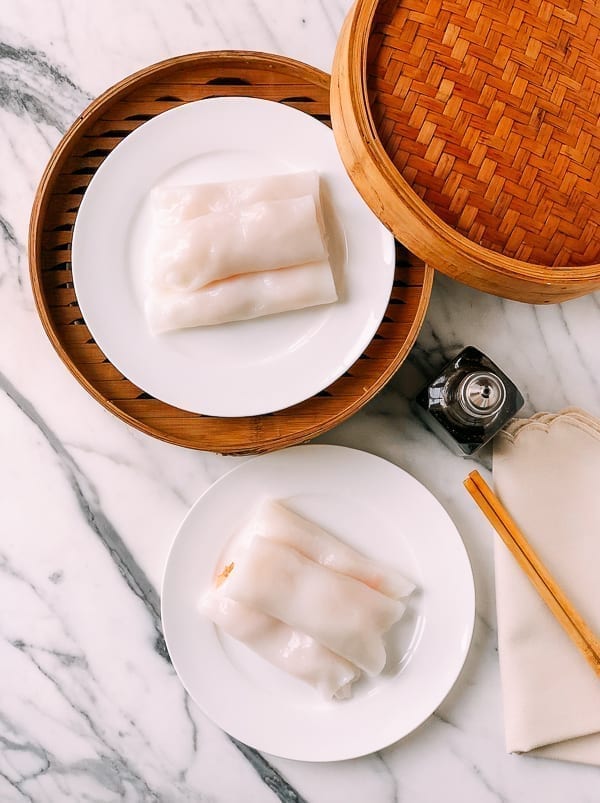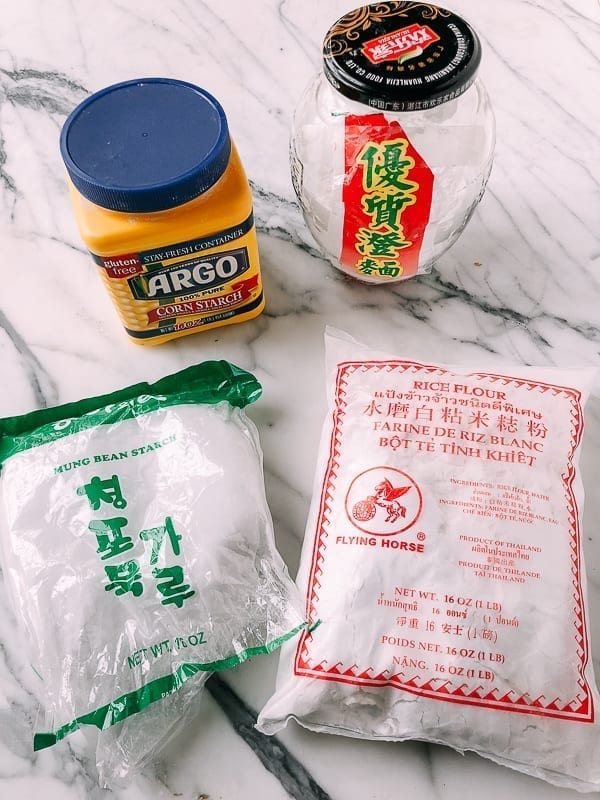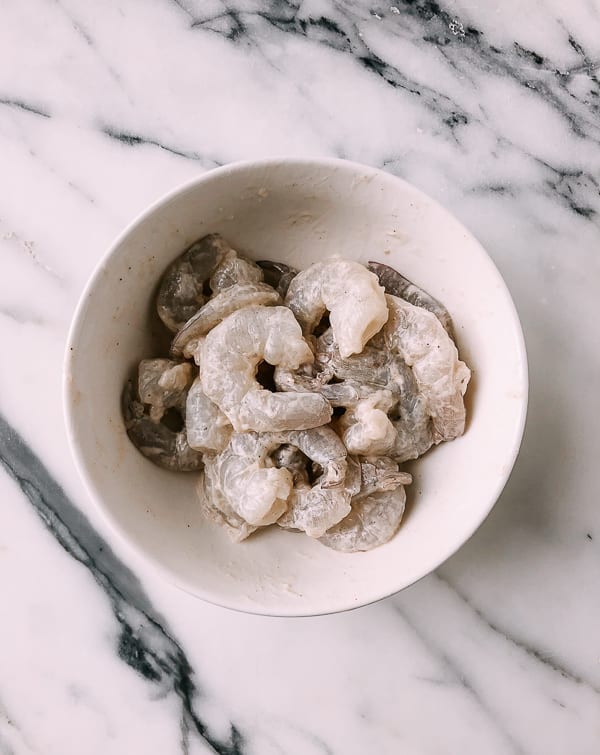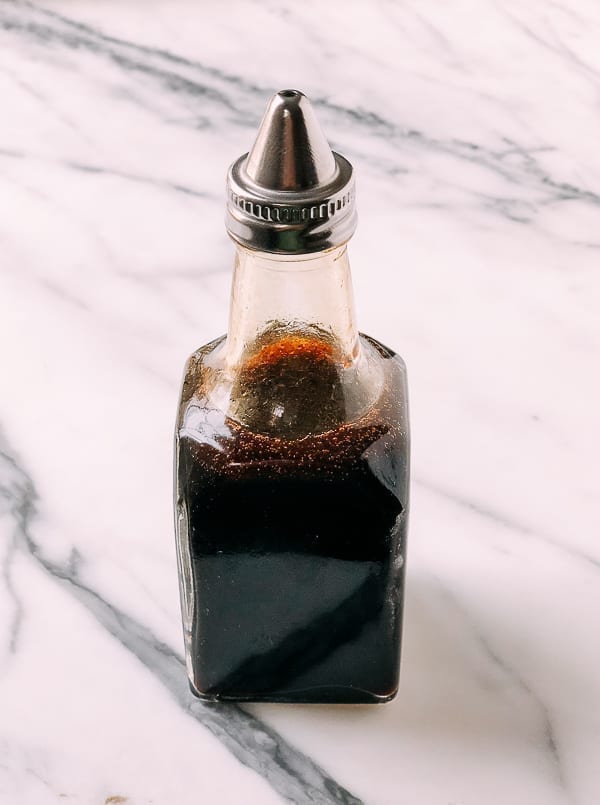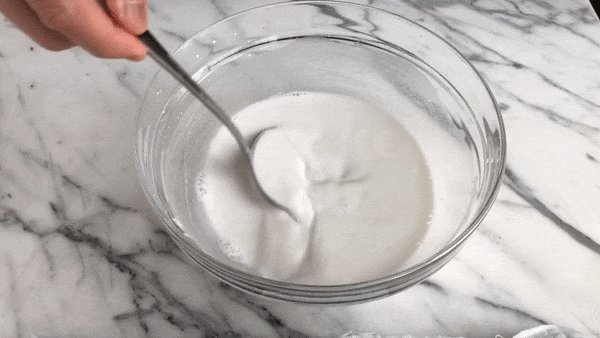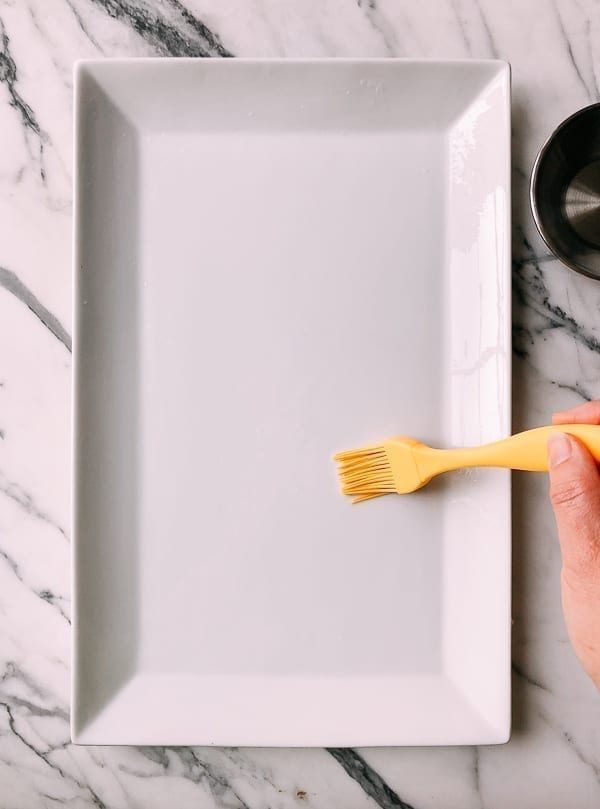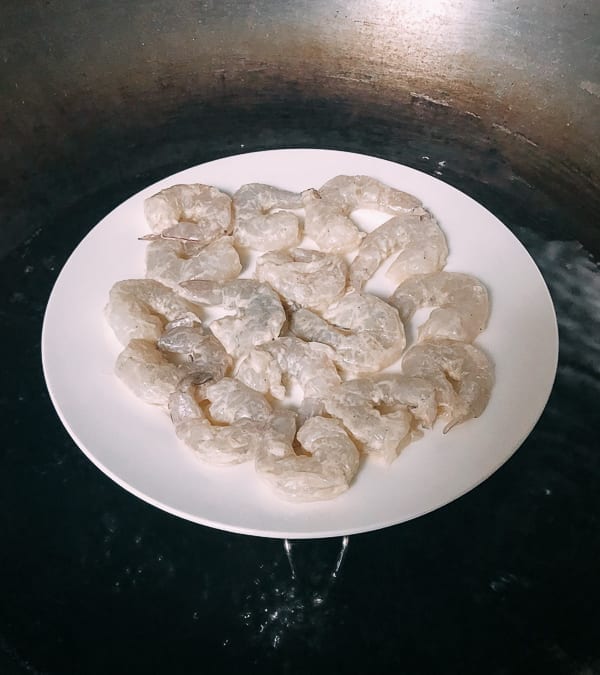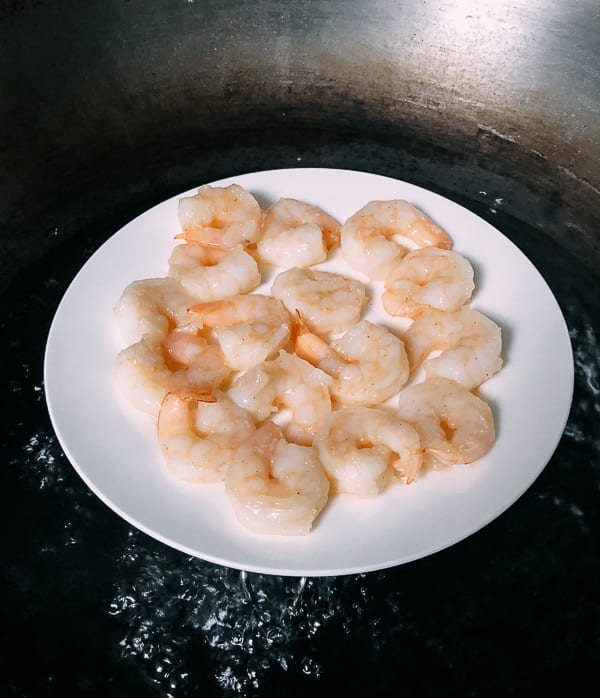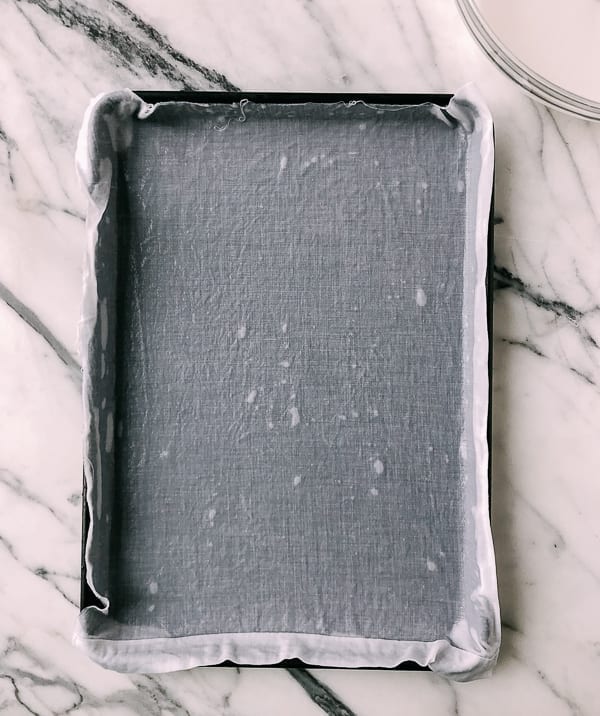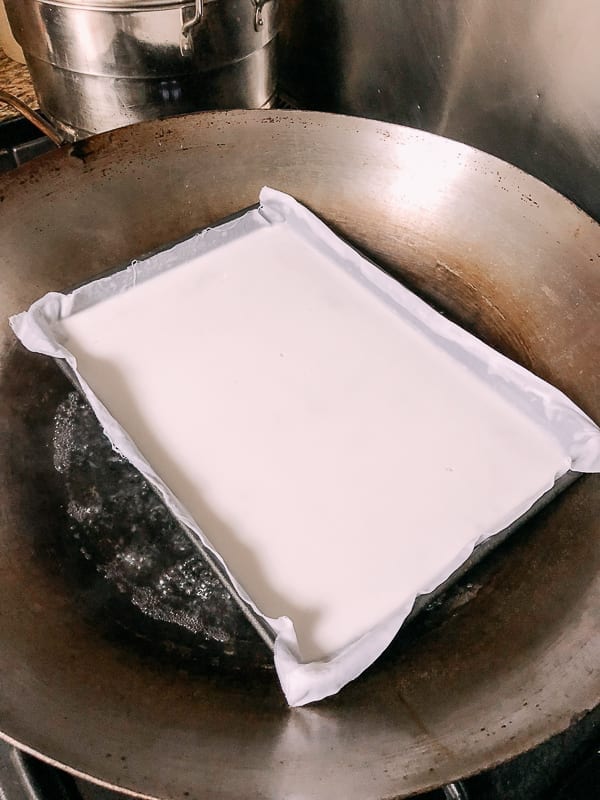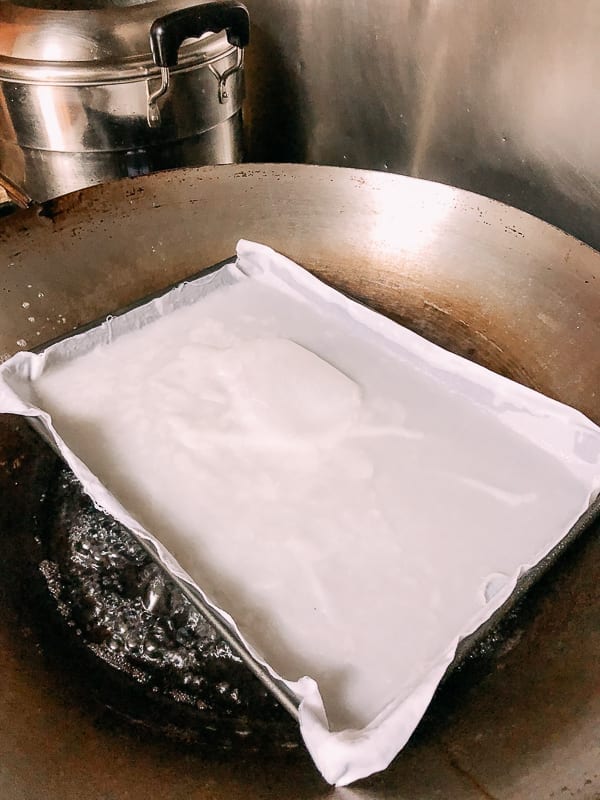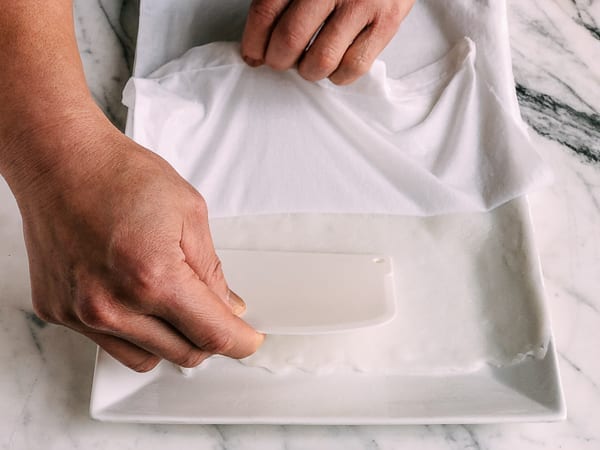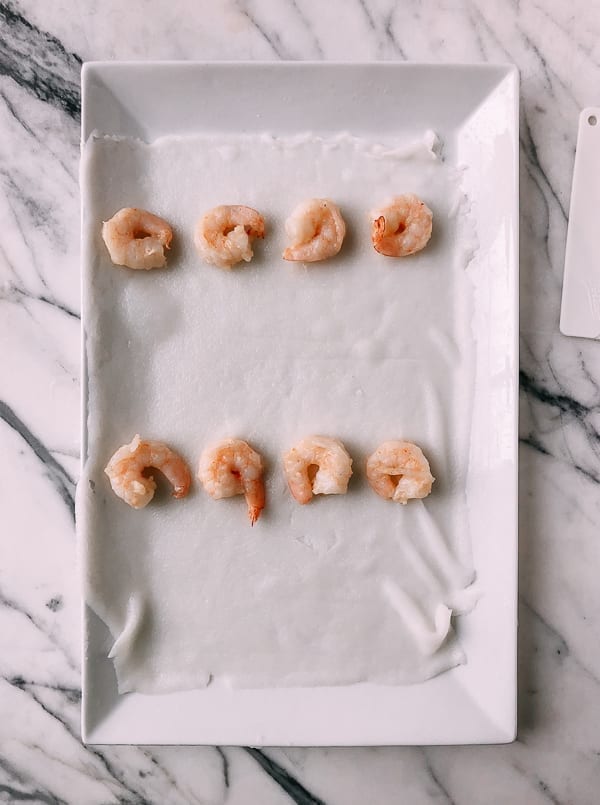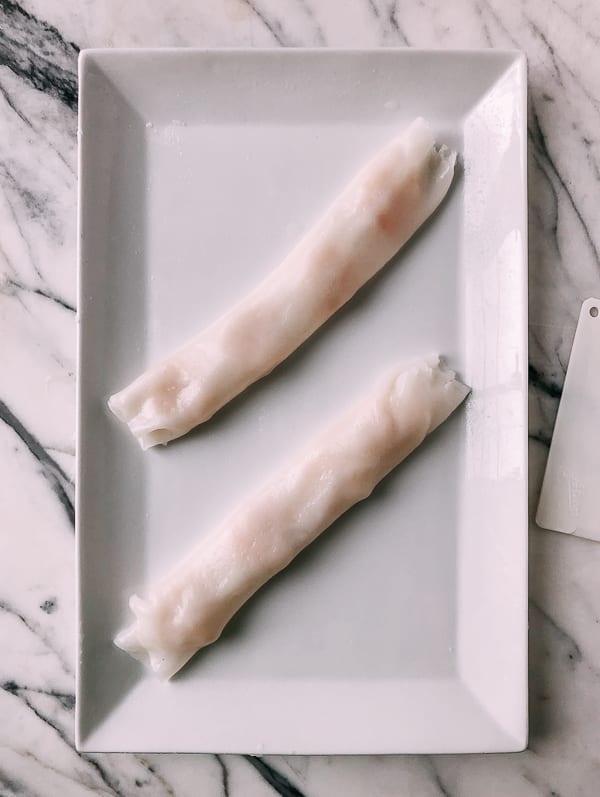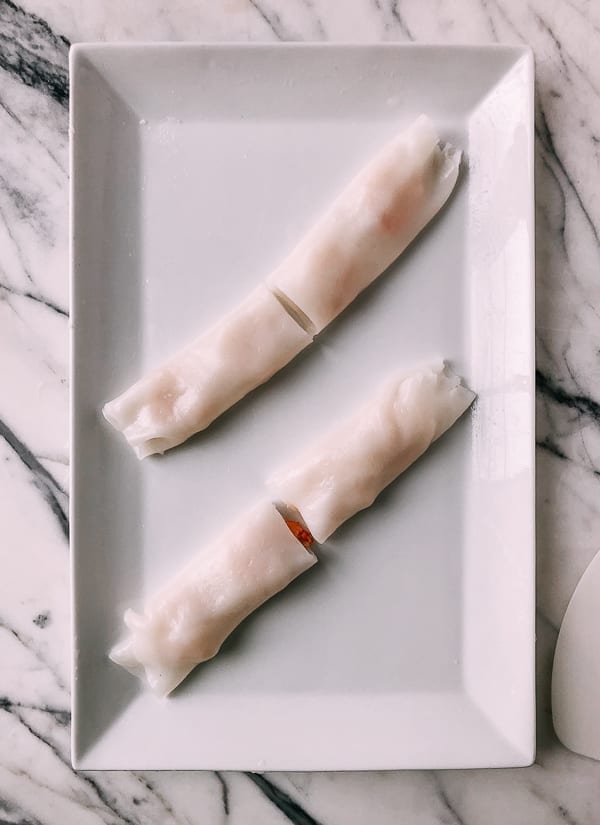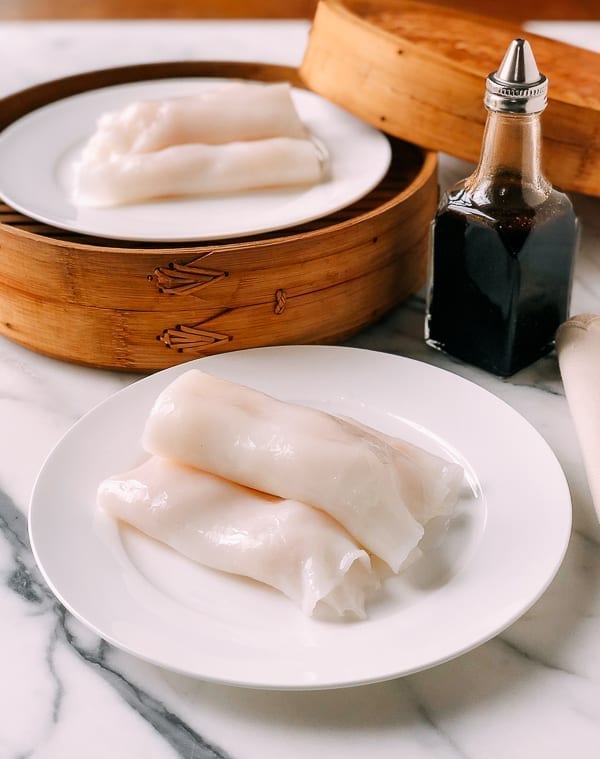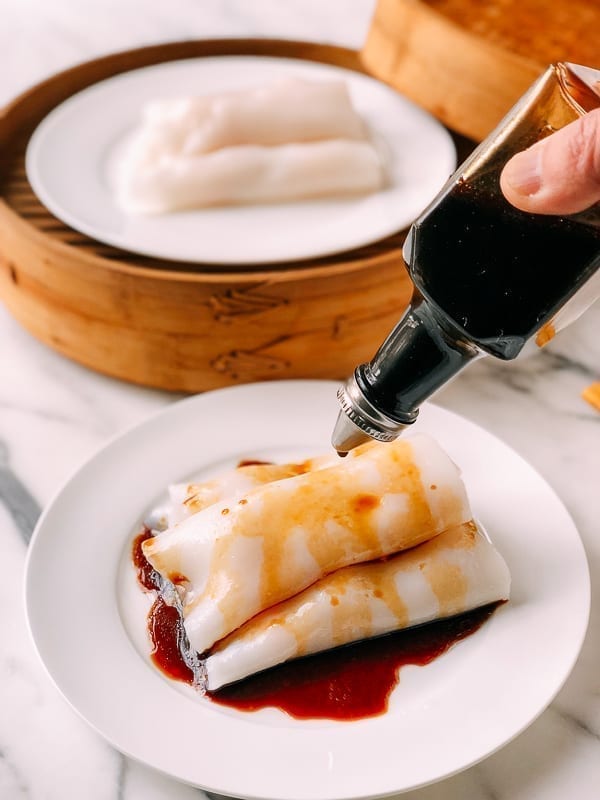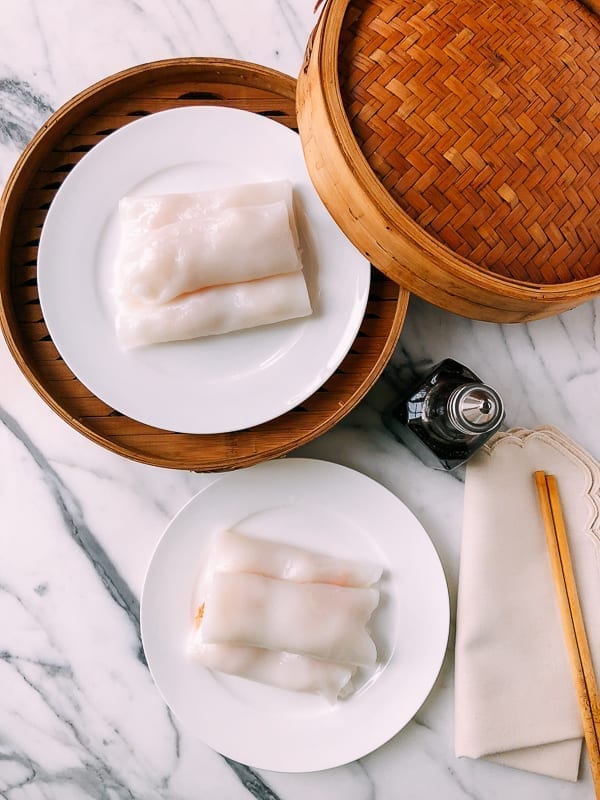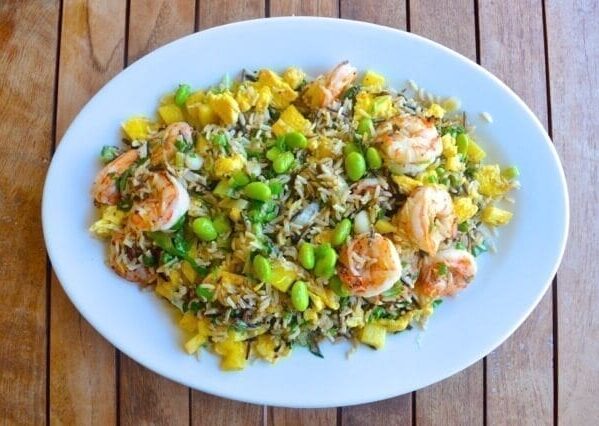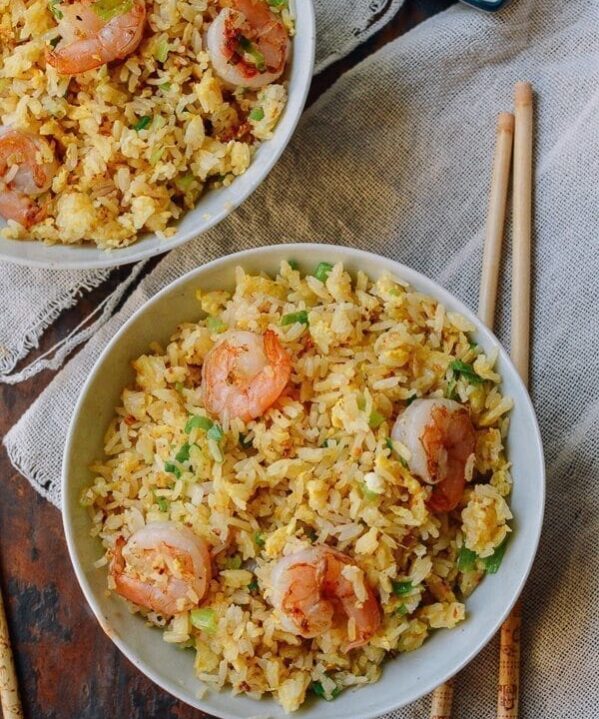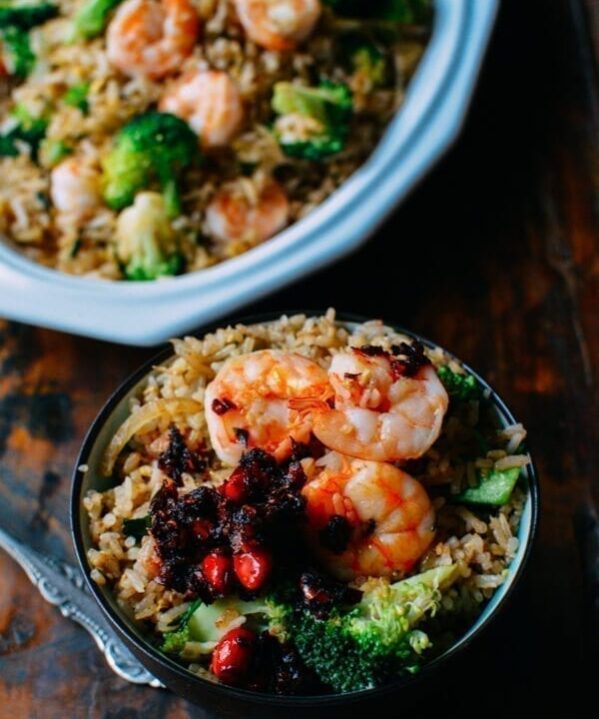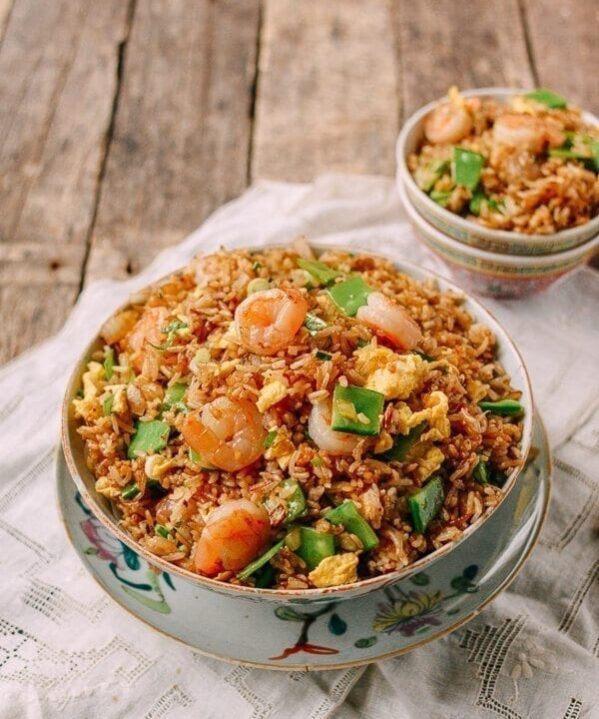No exaggeration, having finished this Shrimp Rice Noodle Roll recipe or xiā cháng fěn in Mandarin (虾肠粉), I feel like I just finished a triathlon lasting many years, except all the pedaling (with whisks), running (around the stove) and swimming (in endless bowls of liquid rice mixtures) took place right here in our kitchen.
After a strenuous recipe-testing saga, I feel good about sharing this Shrimp Rice Noodle Roll recipe––one I’ve worked on for the past three years. Wish you all could have been there in our kitchen to witness the drama and excitement. Now, I feel a heavy weight has been lifted––I even took two days off from blog work afterwards as a reward to myself.
What are Shrimp Rice Noodle Rolls, or ha cheung?
Shrimp Rice Noodle Rolls, or “ha cheung” (Cantonese) are a dim sum classic, and consist of light rice noodles, or cheung fun, wrapped around plump shrimp (either whole or pureed), doused in a sweet soy sauce.
It’s always a favorite at dim sum restaurants, and I’m happy to have cracked the code on a recipe for the home cook.
Important Tips for Making Shrimp Rice Noodle Rolls
- Pre-cooking the shrimp before adding them to the rice roll proved to be key, as the rice batter is so thin that the rice noodle has to be cooked before the shrimp can be placed on top.
- I tested this recipe many times steaming the rice noodles directly in a pan, which resulted in a rough finish. After studying numerous restaurant videos to see their methods, I found that steaming the noodles on cloth is infinitely easier. I cut up a white cotton pillowcase and followed their steps. What a difference!
- This recipe calls for mung bean starch, which is a rarely seen ingredient (and many rice noodle recipes don’t call for it). However, this starch is the main ingredient in glass noodles, and I think it adds a nice texture and chewiness.
- The dry ingredients in the batter will settle to the bottom of the bowl, even after being well-mixed. It must be stirred up every time before being added to the pan to steam. This is VERY IMPORTANT!
- The shrimp marinating steps will make your shrimp more plump and crunchy. Skip only if your shrimp is extremely fresh.
Tools You Need to Make This Recipe
- A metal cake pan, sheet pan, or any heat-proof flat bottomed pan with a rim that can fit in your wok and float on top of simmering water, ideally square or rectangle-shaped.
- A plastic or silicone dough scraper. Though I’ve seen Chinese chefs use cleavers for this purpose, the plastic dough scraper is more user-friendly and does not stick to rice noodles. A spatula can also work in a pinch. If you use a metal utensil, brush it with oil to prevent it from sticking to the rice roll.
- A large wok or steamer with lid (find out more about how to set up a steamer here) that will fit your pan.
- A pastry brush
- A new 100% cotton cloth in white or natural color
- A plate gripper for safely lowering and lifting the hot pan out of the steamer
There are many Shrimp Rice Noodle Roll recipes out there, but they rarely come close to our dim sum expectations. I know because I have tried, tested, and adjusted plenty of them. I do hope this recipe will change that. I hope many of you give this recipe a try, because who doesn’t love this popular Cantonese dim sum? If you do try it, let us know how it went in the comments!
Shrimp Rice Noodle Rolls: Recipe Instructions
Start by preparing the shrimp:
Toss the cleaned shrimp with 2 tablespoons water, 1/2 teaspoon sugar and 1/8 teaspoon baking soda. After the shrimp have been coated, cover and refrigerate for 2 hours.
After 2 hours, rinse the shrimp under a gentle stream of cold running water for 5 minutes to wash away the sugar and baking soda and pat thoroughly dry with a paper towel. This will greatly improve the texture of the shrimp!
Marinate the shrimp with 1/4 teaspoon sesame oil, a pinch of salt, 1/2 teaspoon cornstarch, and 1/4 teaspoon ground white pepper. Cover and return to the refrigerator while you prepare the rest of the ingredients.
Then make the sauce:
Prepare the sauce by adding all the ingredients (1 scallion, white part only, 1-inch piece of ginger, 2 ½ tablespoons light soy sauce, 2 teaspoons dark soy sauce, 5 teaspoons sugar, 1/3 cup water, 1 teaspoon oyster sauce, 1 teaspoon oil, and salt to taste) to a small saucepan over medium low heat.
Heat the sauce until it begins to simmer, and turn off the heat. Cool completely and remove the ginger and scallion. You can store this sauce in the refrigerator for up to 2 weeks.
Then prepare the rice noodle rolls (cheung fun):
Combine rice flour, mung bean starch, wheat starch, cornstarch, and salt in a large mixing bowl. Add the water and stir for at least three minutes until dry ingredients are well dissolved. Set aside and allow time for any air bubbles to dissipate.
Soak the cotton cloth in water so it’s completely saturated.
Prepare a large assembly station by brushing some oil on a clean, smooth surface like a non-porous countertop, a large flat plate, or a smooth cutting board. I’ve found a large smooth plate works best, as it has the least amount of friction:
Pre-boil water in your steamer with the lid on (more on how to set up a steamer here), and make sure your steamer fits the flat-bottomed pan you will use to steam the rice noodles. I used a 9 x 13 non-stick sheet pan. This recipe makes 2 full sheets of rice noodles in this sized pan (equivalent to almost 3 dim sum orders).
First, place the shrimp in a single layer on a plate, and steam them for 2 minutes.
Remove them immediately and set aside.
Now lift the soaking wet cotton cloth out of the water and line the bottom of the pan with it. (Do not wring out the water.)
Stir the rice flour liquid mixture well again before adding just enough to cover the cloth at the bottom of the pan completely. Too much will make the rice noodle too thick. With the water in your steamer boiling, use the plate gripper and carefully lower the pan into the steamer (MAKE SURE THE PAN IS PERFECTLY LEVEL, or the noodle will be too thick on one side and too thin on the other), immediately cover the lid and steam on high for 2 minutes.
Then remove the pan from the steamer with the plate gripper and position it next to your assembly station.
Carefully lift the cloth out of the pan, and place (rice noodle side down) onto the oiled surface. Use the dough scraper and carefully scrape the rice noodle sheet off the cotton cloth onto the oiled surface. Scrape and peel off the cotton cloth at the same time. This step must happen quickly while the noodle and cotton cloth are still hot. The noodle might have a small hole here or there––don’t fret. It does not affect the overall end result.
Cut the rice noodle in half crosswise and line up four cooked shrimp along the edge of each piece.
Roll the rice sheet using the plastic dough scraper to wrap up the shrimp. At this point, you’ll have two long rolls.
Cut each in half, drizzle with the prepared sauce, and eat it while it’s hot.
Rinse the cotton cloth in clean water (no soap or detergent necessary) to remove rice residue before making the next one. These are best when fresh. In this case, we discourage leftovers! Good thing the rice batter is so easy to make!
Shrimp Rice Noodle Rolls (Shrimp Cheung Fun or “Ha Cheung”)
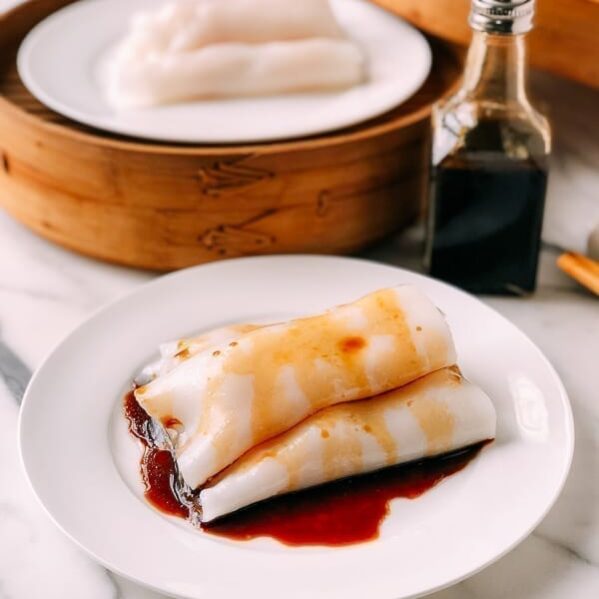
Ingredients
For the shrimp:
- 8 ounces shrimp (16 total 31/40 size shrimp, peeled and deveined)
- 2 tablespoons water
- 1/2 teaspoon sugar
- 1/8 teaspoon baking soda
- 1/4 teaspoon sesame oil
- 1/8 teaspoon salt
- 1/2 teaspoon cornstarch
- 1/4 teaspoon white pepper
For the sauce:
- 1 scallion (white part only)
- 6 slices ginger
- 2 ½ tablespoons light soy sauce
- 2 teaspoons dark soy sauce
- 5 teaspoons sugar
- 1/3 cup water
- 1 teaspoon oyster sauce
- 1 teaspoon oil
- Salt (to taste)
For the rice noodle rolls (cheung fun):
- 5 tablespoons rice flour (40g)
- 1 tablespoon mung bean starch (9g)
- 2 tablespoons wheat starch (18g)
- 2 tablespoons cornstarch (18g)
- 1/4 teaspoon salt
- 1 cup water (235 ml)
- Vegetable or canola oil for brushing
Instructions
To Prepare the Shrimp:
- Toss the cleaned shrimp with 2 tablespoons water, 1/2 teaspoon sugar and 1/8 teaspoon baking soda. After the shrimp have been coated, cover and refrigerate for 2 hours.
- After 2 hours, rinse the shrimp under a gentle stream of cold running water for 5 minutes to wash away the sugar and baking soda and pat thoroughly dry with a paper towel. This will greatly improve the texture of the shrimp!
- Marinate the shrimp with 1/4 teaspoon sesame oil, a pinch of salt, 1/2 teaspoon cornstarch, and 1/4 teaspoon ground white pepper. Cover and return to the refrigerator while you prepare the rest of the ingredients.
To Make the Sauce:
- Prepare the sauce by adding all the ingredients to a small saucepan over medium low heat. Heat the sauce until it begins to simmer, and turn off the heat. Cool completely and remove the ginger and scallion. You can store this sauce in the refrigerator for up to 2 weeks.
To Prepare the Rice Noodle Rolls:
- Combine the rice flour, mung bean starch, wheat starch, cornstarch, and salt in a large mixing bowl. Add the water and stir for at least three minutes until dry ingredients are well dissolved. Set aside and allow time for any air bubbles to dissipate.
- Soak the cotton cloth in water so it’s completely saturated. Prepare a large assembly station by brushing some oil on a clean, smooth surface like a non-porous countertop, a large flat plate, or a smooth cutting board.
- Pre-boil water in your steamer with the lid on (more on how to set up a steamer here), and make sure your steamer fits the flat-bottomed pan you will use to steam the rice noodles. I used a 9 x 13 non-stick sheet pan. This recipe makes 2 full sheets of rice noodles in this sized pan (equivalent to almost 3 dim sum orders).
- First, place the shrimp in a single layer on a plate, and steam them for 2 minutes. Remove them immediately and set aside.
- Now lift the soaking wet cotton cloth out of the water and line the bottom of the pan with it. (Do not wring out the water.) Stir the rice-flour liquid mixture well again before adding just enough to cover the cloth at the bottom of the pan completely. Too much will make the rice noodle too thick. With the water in your steamer boiling, use the plate gripper and carefully lower the pan into the steamer, immediately cover the lid and steam on high for 2 minutes. (MAKE SURE THE PAN IS PERFECTLY LEVEL, or the noodle will be too thick on one side and too thin on the other.)
- Then remove the pan from the steamer with the plate gripper and position it next to your assembly station.
- Carefully lift the cloth out of the pan, and place (rice noodle side down) onto the oiled surface. Use the dough scraper and carefully scrape the rice noodle sheet off the cotton cloth onto the oiled surface. Scrape and peel off the cotton cloth at the same time. This step must happen quickly while the noodle and cotton cloth are still hot. The noodle might have a small hole here or there––don’t fret. It does not affect the overall end result.
- Cut the rice noodle in half crosswise and line up four cooked shrimp along the edge of each piece. Roll the rice sheet using the plastic dough scraper to wrap up the shrimp. At this point, you’ll have two long rolls. Cut each in half, drizzle with the prepared sauce, and eat it while it’s hot.
- Rinse the cotton cloth in clean water (no soap or detergent necessary) to remove rice residue before making the next one. These are best when fresh. In this case, we discourage leftovers! Good thing the rice batter is so easy to make!
Tips & Notes:
- This recipe calls for mung bean starch, which is a rarely seen ingredient (and many rice noodle recipes don’t call for it). However, this starch is a main ingredient in glass noodles, and I think it adds a nice texture and chewiness.
- The dry ingredients in the batter will settle to the bottom of the bowl, even after being well-mixed. It must be stirred up every time before being added to the pan to steam. This is VERY IMPORTANT!
- The shrimp marinating steps will make your shrimp more plump and crunchy. Skip only if your shrimp is extremely fresh.
- Makes 8 rolls
nutrition facts
